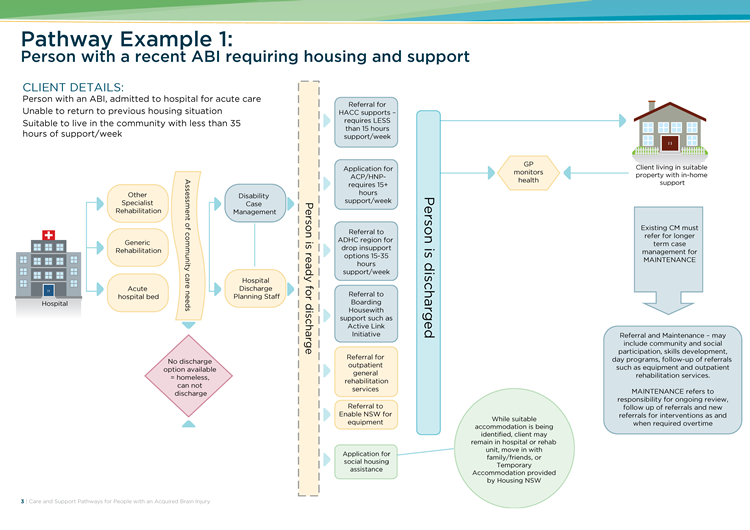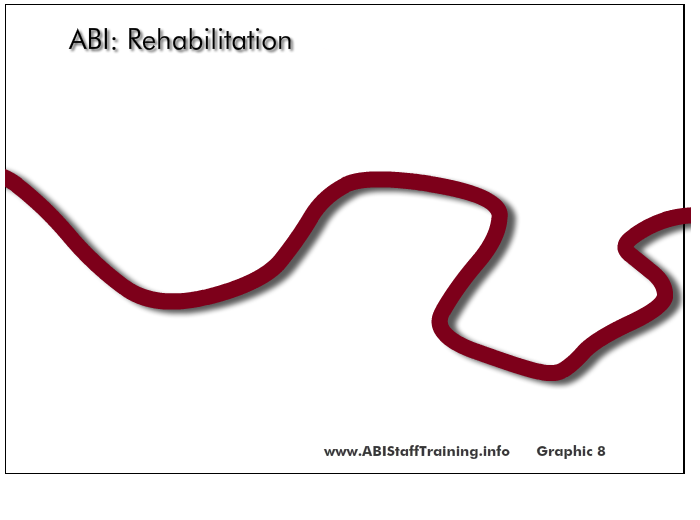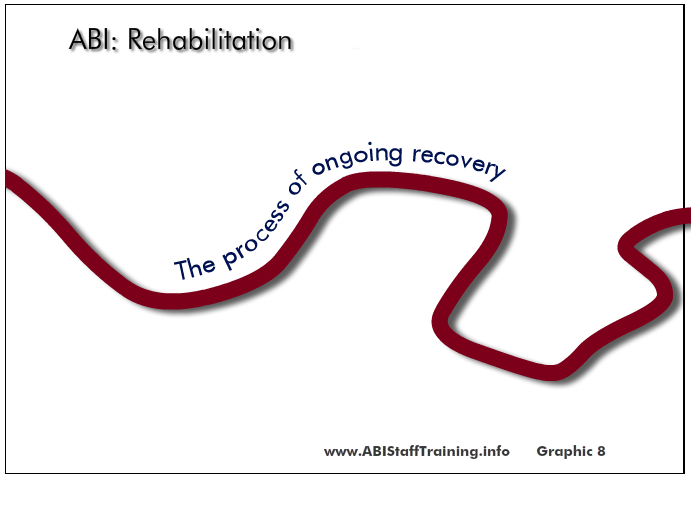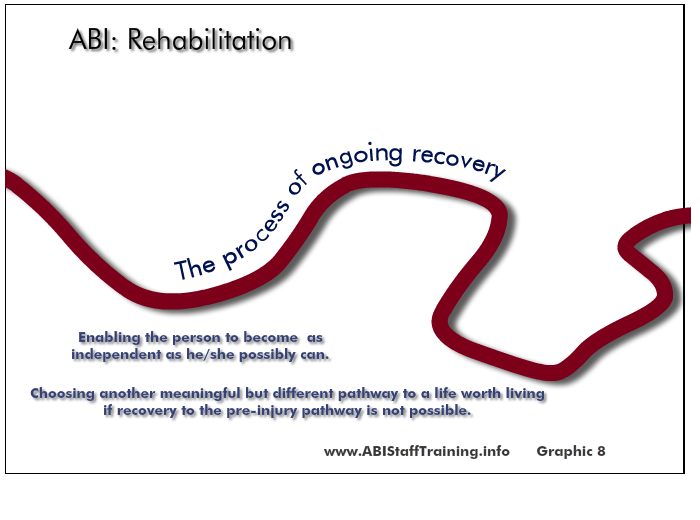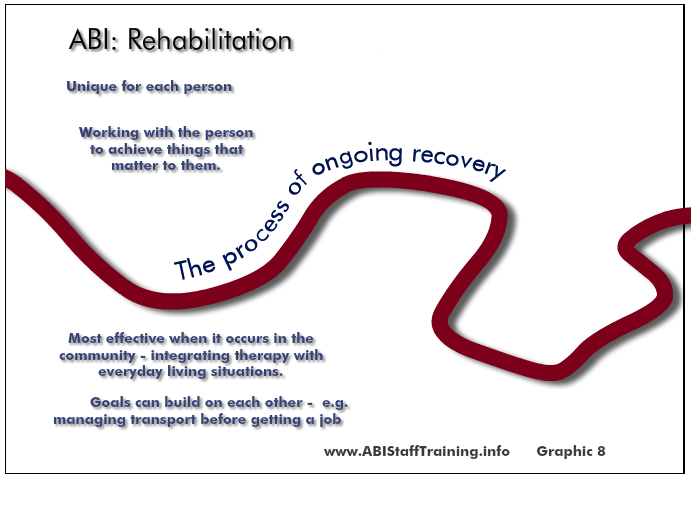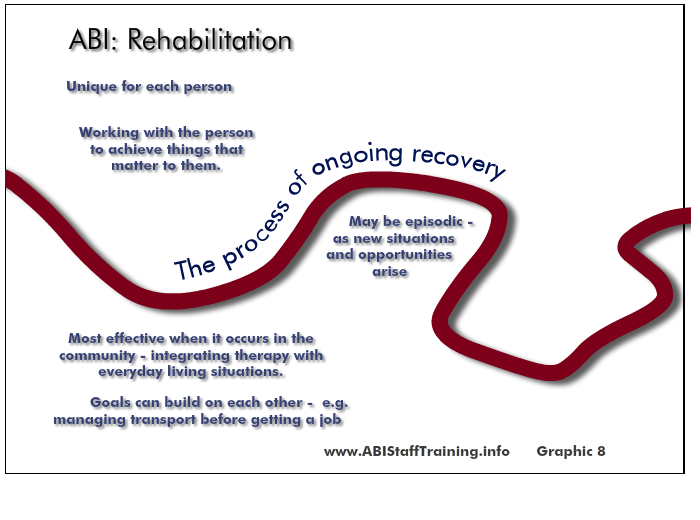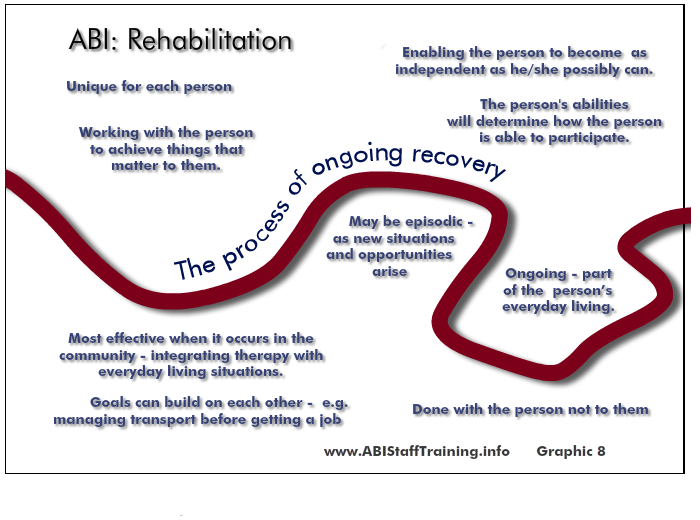- SELF STUDY MODULES
- 1. Intro to TBI
- 2. Communication
- 3. Skills for independence
- 4. Cognitive changes
- 5. Behaviour changes
- 6. Sexuality
- 7. Case management (BIR)
- 8. No longer available
- 9. Mobility & motor control
- 10. Mental health & TBI:
an introduction - 11. Mental health problems
and TBI: diagnosis
& management - 12. Working with Families
after Traumatic Injury:
An Introduction - 13. Goal setting
1.6 Define stages of rehabilitation
- i) The essence of
rehabilitation: Graphic - ii) What is
rehabilitation - iii) Stages
of rehabilitation - iv) Pathways
- v) Pathways
in NSW
i) The essence of rehabilitation
SLIDES:
To pause: Hover mouse over slide. To continue: move mouse off slide.
To go to a specific slide: Click on slide numbers below.
ii) What is rehabilitation
Rehabilitation does not cause recovery, but helps the person make the most of recovery that occurs spontaneously. Most rehabilitation is an active learning process.
Rehabilitation enables a person to become as independent as they possibly can. The goal is for the person to return to their previous abilities, activities and way of life as much as they possibly can. It means enabling the person to live with their remaining abilities and develop strategies to enable them to compensate and overcome new difficulties.
The process of rehabilitation experienced by each person is unique. Just as a brain injury is unique, the type of rehabilitation program the person is engaged in is uniquely tailored to target individual needs. Rehabilitation addresses specific areas of physical difficulty, thinking or cognitive processing, perception, social skills and relationships. It also addresses broader areas of returning to work, getting about in the community, and adjusting to changes a person may experience following a brain injury.
Rehabilitation goals can build on each other, for example managing transport before getting a job.
Rehabilitation is ongoing.
It may also be episodic - as new situations and opportunities arise.
Rehabilitation is not something that is done to the person, rather with the person.
Rehabilitation is based on working with the person to achieve things that matter to them. Therefore, for it to be successful, the individual needs to participate actively in the rehabilitation process. The type of rehabilitation offered needs to be meaningful and relevant to the person. This means the person, their culture, pre-injury lifestyle, family and environment are critical to ensuring the success of rehabilitation.
The person's abilities will determine how the person is able to participate in the rehabilitation process.
Where recovery to the person's pre-injury life pathway is not possible rehabilitation involves choosing another meaningful but different pathway to a life worth living.
(c) Copyright - See: Toolkit B. Working Together Promoting Independence - www.TBIStaffTraining.info
iii) Stages of rehabilitation
Stage 1: Acute rehabilitation
This acute stage involves initial management to ensure the person is medically stable in the Intensive Care Unit and high dependency wards. Acute rehabilitation normally occurs within hospital with a strong focus on physical recovery and regaining independent living skills.
Stage 2: Post-acute rehabilitation/community re-settlement
This stage involves managing the transition from hospital back home, and the ongoing process of rehabilitation that occurs after discharge. The focus of rehabilitation at this stage may include return to work or study, finding alternatives where this is not possible and relearning skills for community living.
Stage 3: Social rehabilitation
This is the long-term rehabilitation aimed at maintaining and enhancing the level of participation in community life that people with TBI can achieve over their life span (community integration).
iv) Pathways
Some of the pathways through rehabilitation are:

V) Pathways in NSW 
Unique individuals mean that service pathways are unique.
At the same time staff need to be aware of:
- typical service pathways
- local barriers to pathways
- strategies for dealing with pathway barriers.
In 2008, an Interagency Agreement was signed between Ageing, Disability and Home Care (ADHC), NSW Health, Housing NSW and the Lifetime Care and Support Authority (LTCS). The purpose of the Interagency Agreement was to improve equity of access in the interface between health, housing and support services to meet the needs of people with ABI in the community.
A Pathways and Protocols Working Group comprising members from each of the inter-agency partners was convened to identify appropriate referral pathways and related issues for an adult with an ABI moving through health, disability and community services. This work has produced: "Care and Support Pathways for People with an Acquired Brain Injury, ![]() Referral and Service Options in NSW". May 2011 (3.1 Meg)
Referral and Service Options in NSW". May 2011 (3.1 Meg)
This document includes 7 Example pathways and detailed information about all of the services mentioned in the example flow charts.
The seven pathway examples are:
1: Person with a recent ABI requiring housing and support
2: Person with a recent TBI requiring support up to 35 hours/week
3: Person with a previous TBI/ABI with drug/alcohol or mental health issues
4: Person with TBI/ABI with challenging behaviours
5: Person with previous TBI/ABI exiting prison system
6: Applicant or existing tenant of Housing NSW with a diagnosed or undiagnosed ABI/TBI
7: Person with TBI/ABI requiring formal support for more than 35 hours per week
People who sustain injuries in motor vehicle accidents (MVA) may have access to compensation (Workcover, LTSCA). This can increase service options and needs to be considered when planning service support.
Example 1: Person with a recent ABI requiring housing and support
